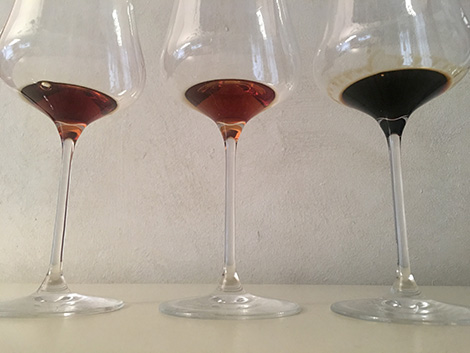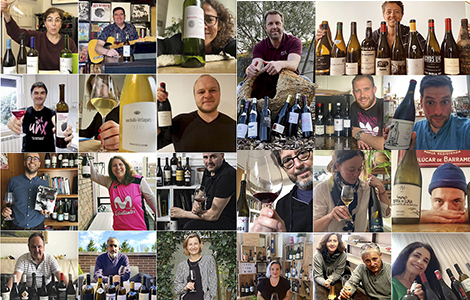
It was a wonderful coincidence that I managed to fit in a visit to González Byass on my last trip to Jerez. It was a promising plan: to delve into the rich heritage of this historic house guided by its technical director Antonio Flores. We got to experience three different parts of this legacy: the documents in the archive, the liquid part (the oldest wines kept in casks) and the fascinating bottle cellar housing a great number of old bottlings that was officially presented in the last edition of Vinoble two years ago.
Three weeks later, upon my return to Madrid, I received invitations to the relaunch of Barbadillo’s Reliquias and a promising wine and food pairing event showcasing Osborne’s finest Rare and VORS sherries. They are expensive, extremely scarce wines, but I can't think of a more soothing and profound sip to end a difficult year that has deprived us of gestures of love and affection.
About Popes, forgotten casks and unique bottles
Visiting the historical González Byass wine cellar is a once in a lifetime experience, more so if you are given the chance to taste side by side some very special bottlings like León XIII and Pío X. Both are sweet wines made on the occasion of the appointments, in 1878 and 1903 respectively, of the two popes who bode farewell to the 19th century and welcomed the 20th.

They are incredibly different, like some sort of sherry ying and yang. León XIII 1878 (a limited edition of 80 bottles was released in October at €1,800) is the densest and most concentrated Pedro Ximénez I have ever come across. When I tried to take a sip, it moved slowly towards my lips coating the glass in such a way that it seemed I wouldn’t be able to taste a single drop of it. Deep and sticky, it’s pure concentration and raisin essence. Pío X 1903 is much lighter. As it is made from Moscatel, the acidity feels more concentrated adding a lively, almost crystalline definition to its glorious citrus (orange peel), coffee and candied nuances. After all these years, it is astonishingly refined and balanced.
Alcohol in both wines is under 10% abv. Antonio Flores reminded us that sweet wines were not fortified in the past -González Byass in fact maintained this style in Noé PX until the 1980s but now a minimum of 15% abv. is required by the Regulatory Board. Grapes used for Pío X are believed to be Moscatel de Grano Menudo (Muscat à Petit Grains) which were widely planted in the region prior to phylloxera. The remaining 90 litres rescued from an ancient cask were released in 2019 at the same price that León XIII.
A youngster at their side, Viña Dulce Nombre 1986, released this year at €96, completes the range of sweet wines. This is made from late-harvested, sun-dried Palomino grapes, a variety that is almost entirely used for dry sherry. Consequently, there are raisin notes as well as the nuttiness that comes with cask ageing. A vintage sherry as well, it is less powerful that the previous ones, with vibrant acidity and less residual sugar: 220g per litre against the 600g of the PX and the 650g of the Moscatel.
These bottlings are part of the new González Byass range of “vinos finitos” (finite wines), featuring extremely limited releases of forgotten casks and styles that would be impossible to replicate at present. A recent addition comes from six 40-year-old, largely forgotten casks which used to be part of the Alfonso solera. Two of them were recently released as Alfonso 1/6 and Alfonso 2/6 (€96, 50cl. Bottle). Antonio Flores describes this wine as an Oloroso Fino, a refined, restrained version of present day Olorosos that he thinks may have given birth to Palo Cortado.
All these wines, together with the impressive Cuatro Palmas (€120, 50cl bottle), the extremely old Amontillado that is part of the Finos Palmas, fetch prices well above the VORS range with an average age of at least 30 years (Amontillado del Duque, Apóstoles Palo Cortado, Noé PX and Matusalem Cream) which are sold for around €70.
Punk relics
To say that these special wines should be sold at high prices seems beyond doubt. Producers are increasingly keen to explain the wines’ unique features and set them apart on the market. Nobody has probably adopted this strategy as far as Barbadillo, who has presented a radical change in its Reliquias packaging. These extremely limited, century-old wines have substituted the sumptuous 75cl. glass decanters costing €1,000 each for traditional 35cl. Sherry bottles costing slightly over €300. But the most striking feature is the new, ultramodern, radical labels; perhaps the boldest design in the area in recent years.
Armando Guerra, who is in charge of premium wines at Barbadillo, has engaged in an exercise of introspection and audacity. Seeking a label as artisanal as the liquid inside the bottles, he teamed up with calligrapher Goyo Valmorisco to hand paint, one by one, each of the 80 Amontillado, Palo Cortado and Oloroso labels that were recently released, as well as 16 bottles of PX. The artist let himself be inspired by his impressions of the four sherries to create a unique typeface for each one of them (see the image above).
Those lucky enough to taste the Oloroso will understand at once the deep colour saturation of the design. It matches its powerful, spirit-like warmth nuanced by iodine, nutty and spicy (nutmeg) notes. The excellent acidity and creamy texture provide unexpected refinement, but this wine is as big as it is extreme.
Wine experts and sherry lovers will surely love the Palo Cortado. A super complex, saline nose (nuts, crème brûlée, varnish, sea breeze) precedes a broad palate, with vibrant acidity and lingering pistachio flavours leading to an eternal finish. The artist has used the finest strokes of the range on this label.
The Amontillado is the finest and most elegant of this collection, so if you have the chance to taste these sherries in one flight, you should start with this one; otherwise this lovely wine would be overshadowed by the Palo Cortado and completely obliterated by the Oloroso. It’s ethereal and creamy, with salted almonds, fine wood, sweet spices and lovely salinity and length. The label seems inspired in the Orient. As for the PX and despite its usual concentration, it also shines for its finesse, hence the velvety texture and the elegant raisin, toffee and coffee aromas.

The re-launch of the Reliquias also means novelties in terms of their sale. While Barbadillo's technical director, Montserrat Molina, limited the sacas (withdrawal of wine) to 40 bottles per year in 2015 when decanter bottles were still in use, an allocation system is now in place with release dates set for November. As Armando Guerra explains, the average age of these scarce and rare wines exceeds 100 years.
Rare vs VORS
My third stop in this fascinating journey was a tasting featuring some of Osborne's premium sherries. The diversification undertaken by the company in recent years (while Iberico ham currently accounts for 46% of its turnover, non-fortified wine is down to 12% and sherry represents a mere 2%) has not stopped them from committing to quality as far as sherry is concerned. Following the purchase of the legendary VORS range from Domecq in 2008, the company now has nine premium wines featuring two different styles. Last year, the house’s vintage labels were dropped in favour of a luxury, refined look.
The finest Osborne sherries are now called Rare. According to PR manager Rocío Osborne, these soleras -all of them containing some sweet PX- were initially conceived for very specific clients and were refreshed with wines from Balbaína, a prized vineyard which partly lies near El Puerto de Santa María where Osborne has its headquarters. Some used to be sold as Oloroso or Palo Cortado but, as of most of the blends have a sweet base, they must now be classified as Medium, which is an unusual category for top sherries. Hence, Osborne decided to drop the VORS seal and call them "Rare" instead.
Most of the Rare soleras originated in the early 20th century, except BC, a blend created in 1864 for the Russian imperial family. The average of these Rare wines is 25 to 40 years, whereas the Domecq soleras meet the 30-year average age requirement to be labelled as VORS. Fed with sobretablas (base wines) from the Macharnudo vineyard, they were created at an earlier stage: 1792 (Sibarita Oloroso), 1790 (Capuchino Palo Cortado) and 1830 (Amontillado 51-1ª). The youngest solera, started in 1902, is PX Venerable.

The styles are very different, -residual sugar marks the Rare sherries. Only the AOS Amontillado is dry and stands out for its exuberance (crème brûlée, varnish, toasted nuances) in contrast with the austere finesse of the 51-1ª VORS. In terms of oxidative sherries, there is a sharp contrast between Sibarita VORS -a serious, dry, powerful and sapid Oloroso- and the rich, opulent BC which, despite its 50g of residual sugar, doesn’t taste particularly sweet.
Going up in sweetness, Solera India (70g) lives up to its name and displays oriental spices, exotic wood and a round, gentle palate. Solera P Triángulo P (90g) is closer to the comforting, warm style of a Palo Cortado, but once again feels richer than the Capuchino VORS that falls within this category.
The contrast is also notable in the sweet PX wines. Not as full-bodied and with vibrant acidity, Venerable VORS is exotic and Christmasy with its vanilla, candied orange peel and chocolate aromas. The Rare PX is thicker and more concentrated (evidenced in the sediments on the sides of the bottle) with classic raisin, toffee and dark chocolate aromas. Dark and deep, it feels almost endless. It stays on your palate.
A great deal of the strong appeal of Osborne’s premium wines comes from the fact that the two ranges are truly different, even in the ageing process -the VORS casks occupy a space in the centre of the cellar so that they are better sheltered; and the stronger Rare sherries are placed next to entrance and exit areas.
As with other premium sherries, the sacas are carefully monitored so that the average age of the wines is preserved. Quantities range from 1.5% to 3% -it translates into 745 bottles of the Rare PX and a maximum of 3,330 bottles in the case of Sibarita Oloroso. A bottle of the Rare range will set you back €195 and €80 for the VORS.
THE CURIOUS CASE OF THE WINES THAT TRAVEL THE SEAS
A couple of years ago González Byass played the exclusivity card drawing on the extensive literature stored in its historic archive. The sherry house revived the “vinos de ida y vuelta” (literally, there and back wines), an extended practice registered in the inventories of Sherry producers until the end of the 19th century. Known also as “vinos mareados” (seasick wines), these sherries were sent off on a ‘round trip’ across the seas to speed up the ageing process. The records in the González Byass archive indicate the number of casks travelling on frigates, normally on route to Manila (Philippines).
It was a well-established, profitable service for sherry producers because the price of the wines increased significantly upon their return. “The insured cargo and its manifesto were handed to the captain and the shipping company charged its fee,” explains Flores.
It was a complicated process, but González Byass managed to reach an agreement with the Spanish Navy to revive the experience in 2018 on board the training ship Juan Sebastián Elcano. The main problem, says Flores, was to find a place for the casks giving the lack of space. The only feasible option was to remove two old machine guns from the deck and replace them with two 250-litre casks. As they were on deck exposed to the weather (unlike the voyages of yesteryear), they were placed inside two particularly resistant marine wooden boxes that were anchored on the port and starboard sides of the vessel. The casks were not fully filled to adapt to the constant rolling of the waves. A 128-litre barrel was also shipped for the crew, which they conveniently shared at some of the stops on their journey.
The chosen wine was a 1990 Palo Cortado with excellent ageing potential. Subject to the steady motion, extreme oxygenation and sudden changes in humidity and temperature, the wine upon its return seemed fuller and richer. According to Flores, the analytical data indicated that it had aged the equivalent of five to six years. González Byass released some 500 bottles and a limited series of boxes (€550 on the winery's website) to compare the wine that remained in the winery, presented in 200 ml. bottles, with the one that returned six months later in the standard 75cl. bottle. The wine was named XC Palo Cortado.

This year, despite the additional difficulties caused by the pandemic, González Byass raised to the challenge of embarking a cask of sherry aged under flor on a longer voyage commemorating the first circumnavigation of the globe. The ship left in August and is expected to return in June 2021. "The wine on board is a Fino Amontillado from the Viña AB solera, still with a veil of yeasts. It was placed in the sail storage area, in the submerged section of the ship," explains Flores.
This location provides extra humidity and fairly constant temperatures. But we'll have to wait for the result. At this time of the year, the Juan Sebastian Elcano is sailing alongside Ecuador.

Amaya Cervera
A wine journalist with almost 30 years' experience, she is the founder of the award-winning Spanish Wine Lover website. In 2023, she won the National Gastronomy Award for Gastronomic Communication
NEWSLETTER
Join our community of Spanish wine lovers






